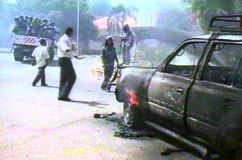Deadly riots hit Sudanese capital after death of Garang
KHARTOUM, Aug 1 (AFP) — Deadly rioting rocked the Sudanese capital after a helicopter crash killed Sudan’s new vice president and ex-southern rebel leader John Garang, dealing a blow to a fledgling January peace deal that ended Africa’s longest-running war.

|
|
Police stand next to a burning car in Khartoum, Sudan Monday Aug. 1, 2005. (AP). |
Authorities imposed a dusk-to-dawn curfew on the capital following the violence that erupted when thousands of people, some wielding knives and guns, took to the streets of Khartoum immediately after Garang’s weekend death was confirmed.
Bursts of automatic gunfire could be heard and an AFP correspondent saw several people lying wounded, some possibly dead, while a European diplomat cited reports of dead bodies in streets where cars had been set ablaze.
The United States dispatched two senior envoys to Sudan on Monday in hopes of keeping the peace process on track.
Connie Newman, assistant secretary of state for African affairs, and Roger Winter, special representative for Sudan, headed for Khartoum and the country’s south, according to State Department spokesman Tom Casey.
Casey said the two would “confer with the parties and encourage them to maintain momentum on the comprehensive peace agreement” signed in January to end two decades of civil war.
Top political and military officials of southern Sudan’s former rebel group, the Sudan People’s Liberation Movement/Army (SPLM/A), convened a crisis meeting to elect a leader to replace Garang and plan his funeral.
“The purpose of the meeting is the management of a national crisis. We are mourning, but we have the courage to move forward and complete the mission,” said Pagan Amum, a political operative in Rumbek, the provisional capital of autonomous southern Sudan.
In Khartoum, authorities released no official death toll following the rioting, but the situation appeared to have been brought under control after security deployed en masse in the capital and the curfew took effect at 1500 GMT, witnesses said.
Meanwhile, residents of the southern town of Juba, which is to become the capital of the southern region, said angry protesters had burned and vandalized businesses and property owned by northern Sudanese Arabs.
They are seen as close to the Islamic government in Khartoum against which the SPLM/A had until January fought for 21 years.
“It’s calm now,” one witness said, adding that the situation had quieted after an appeal for restraint by SPLM leaders but noting that smoke could still be seen rising from shops and property that had been torched earlier in the day.
The situation in Khartoum and Juba turned ugly after Sudanese President Omar el-Beshir confirmed that Garang had died en route from Uganda to his base in southern Sudan when the Ugandan Russian-built helicopter in which he was traveling crashed in Sudan’s Eastern Equatorial province near the border with Uganda.
The crash, which Ugandan officials blamed on poor weather, “resulted in the death of John Garang and six people accompanying him as well as seven members of the crew of the Ugandan presidential aircraft,” Beshir said in a statement read on state television.
Garang had been returning to his New Site base after talks with Ugandan President Yoweri Museveni and US and European diplomats about the progress in implementing the January 9 peace deal to end the long-running war that killed more than 1.5 million and forced millions of others from their homes.
In Kampala, Museveni told Ugandan lawmakers that he had ordered a probe into the crash and said his government had contacted an unspecified foreign power to confirm it had been an accident and not the result of “sabotage or terrorism.”
A Ugandan official said none of the 14 people on board Museveni’s MI-172 executive helicopter, purchased eight years ago, had survived.
Garang, 60, the head of the SPLM/A, became Sudan’s vice president only three weeks ago when the January peace agreement signed in Kenya began to be implemented in earnest with the formation a new national unity government.
His death sparked immediate concerns for the agreement as well as for peaceful resolutions to conflicts in Sudan’s troubled western Darfur region and the restive east of the country where rebel groups have complained of discrimination and repression similar to that which prompted the SPLM/A to take up arms in 1983.
Many had seen the north-south deal and in particular Garang’s new position in Khartoum and credibility among mainly Christian and animist black Africans as hopeful signs for resolving Sudan’s other disputes.
And despite vows from Beshir and the SPLM/A leadership to carry on with the peace deal, many analysts and previous mediators voiced concerns that Garang’s absence from the scene would be hinder efforts to secure peace.
“We guarantee that the peace process will continue progressing in the same direction,” Beshir said in his statement. “His passing will only reinforce our determination to pursue the peace process.”
